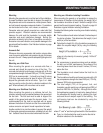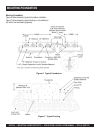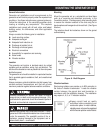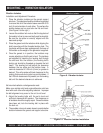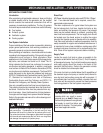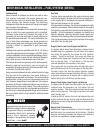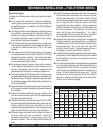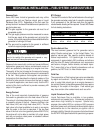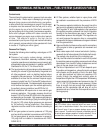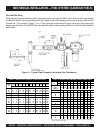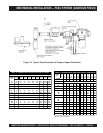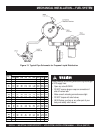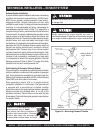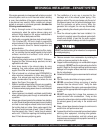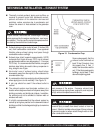
INDUSTRIAL GENERATOR SETS — APPLICATION & INSTALLATION MANUAL — REV. #4 (09/07/07) — PAGE 41
MECHANICAL INSTALLATION — FUEL SYSTEM (GASEOUS FUELS)
Gaseous Fuel Supply
Consider the following when installing a natural gas or LPG
fuel system:
Gaseous fuel supply system design, materials,
components, fabrication, assembly, installation, testing
inspection operation and maintenance must comply with
all applicable codes and standards. In addition, see NFPA
Standards No. 30, No. 37, No. 54 and No. 58.
The layout and sizing of gas piping must be adequate for
handling the volume of gas required by the genset and
all other equipment, such as building heating boilers
supplied by the same source. Full load gas flow must be
available at not less that the minimum required supply
pressure, typically from 5 to 10 inches WC (water column)
depending on the model. Final determination of pipe sizes
must however be based upon the method approved by
the authority having jurisdiction (see NFPA No. 54).
Most installations will require one or more service gas
pressure regulators. Gas supply pressure should not
exceed 13.8 or 20 inches WC at the inlet to the generator
set depending on the model. High pressure gas piping is
not permitted inside buildings (5 psig for natural gas and
20 psig for LPG unless higher pressures are approved
by the authority having jurisdiction). Gas pressure
regulators must be vented to the outdoors according to
code.
All fuel gas systems at service pressures of 125 psig
and less shall be installed in accordance with NFPA 54.
All fuel gas systems at service pressures in excess of
125 psig shall be installed in accordance with ANSI/
ASME B31.3.
LP-Gas systems, whether liquid or vapor phase, shall
be installed in accordance with the provisions of NFPA
58.
The pressure regulator installed on the supply line at the
gas source for generator applications should never be a
“pilot” regulator. A “pilot” style regulator is the type where
the regulator requires a pressure line from the regulator
housing to the downstream gas pipe to “sense” when
downstream pressure has dropped. Pilot regulators do
not work because the response time is unacceptable
compared to the large–instantaneous changes in demand
from the generator set.
Approved flexible fuel hose must be used for connections
at the engine to take up generator set movement and
vibration.
Most codes require both manual and electric (battery–
powered) shut-off valves ahead of the flexible fuel hose(s).
The manual valve should be of the indicating type.
A dry fuel filter should be installed in each line to protect
the sensitive pressure regulating components and orifices
downstream from harmful foreign substances carried
along in the gas stream (rust, scale, etc.).
The rate of vaporization in an LPG tank depends upon
the outdoor air temperature, unless the tank is equipped
with a heater, and the quantity of fuel in the tank. Even
on cold days ambient air heats and vaporizes LPG
(mostly through the wetted tank surface) when air
temperature is higher than LPG temperature. Withdrawing
vapor causes tank temperature and pressure to drop. (At
–37° F [–38° C] LPG has zero vapor pressure.) Unless
there is enough fuel and enough heat available from
ambient air, the vaporization rate will drop off, as the
generator set runs, to less than that required to continue
running properly.
Contaminants
The most harmful contaminants in gaseous fuels are water
vapor and sulfur. Water vapor is damaging to an engine
because it may cause uncontrolled burning, pre-ignition,
or other effects that can damage an engine. Liquid vapor
or droplets must be removed from the fuel prior to entry
into the engine by use of a dry filter that is mounted in
the fuel system prior to the primary fuel pressure regulator.
Sulfur and hydrogen sulfides will cause corrosion and
serious damage to an engine over a relative short periods
of time. The effects of sulfur in the fuel can be
counteracted in part by use of high-ash natural lubricating
oils. In general, engines should not be operated with fuels
in excess of 10 parts per million (ppm).
Leakage of gaseous fuel is extremely dangerous. Natural gas
and LPG contain carbon monoxide which can cause severe
bodily harm or
death when inhaled. Also, serious explosions
and fires will occur if gas or propane leakage occurs where
there is a spark. To prevent such hazards, immediately shut off
all natural gas or propane supplies if a leak is detected. If in an
enclosed area, ventilate the area as quickly as possible.



